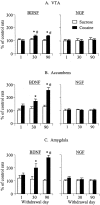Time-dependent increases in brain-derived neurotrophic factor protein levels within the mesolimbic dopamine system after withdrawal from cocaine: implications for incubation of cocaine craving
- PMID: 12574402
- PMCID: PMC6741929
- DOI: 10.1523/JNEUROSCI.23-03-00742.2003
Time-dependent increases in brain-derived neurotrophic factor protein levels within the mesolimbic dopamine system after withdrawal from cocaine: implications for incubation of cocaine craving
Abstract
Using a rat model of drug craving, we found that the responsiveness to cocaine cues progressively increases or incubates over the first 60 d of cocaine withdrawal. Here we studied whether alterations in brain-derived neurotrophic factor (BDNF) protein levels within the mesolimbic dopamine system are associated with this incubation phenomenon. BDNF is involved in synaptic plasticity and was found to enhance responding for cues associated with natural rewards. Rats were trained to press a lever to receive intravenous cocaine or oral sucrose for 6 hr/d for 10 d; each earned reward was paired with a tone-light cue. Resumption of lever-pressing behavior was then assessed on days 1, 30, or 90 of reward withdrawal. First, resistance to extinction was assessed during 6 hr in which lever presses were not reinforced and the cue was absent. Second, cue-induced reinstatement was assessed after extinction during 1 hr in which responding led to cue presentations. Other rats were killed without testing on days 1, 30, and 90 of reward withdrawal, and BDNF and nerve growth factor (NGF) protein levels were measured in the ventral tegmental area (VTA), accumbens, and amygdala. Lever pressing during extinction and cue-induced reinstatement tests of cocaine craving progressively increased after cocaine withdrawal. Time-dependent changes also were observed during the tests for sucrose craving, with maximal responding on day 30. BDNF, but not NGF, levels in the VTA, accumbens, and amygdala progressively increased after cocaine, but not sucrose, withdrawal. Time-dependent increases in BDNF levels may lead to synaptic modifications that underlie enhanced responsiveness to cocaine cues after prolonged withdrawal periods.
Figures



References
-
- Everitt BJ, Parkinson JA, Olmstead MC, Arroyo M, Robledo P, Robbins TW. Associative processes in addiction and reward. The role of amygdala-ventral striatal subsystems. Ann NY Acad Sci. 1999;877:412–438. - PubMed
-
- Gawin FH, Kleber HD. Abstinence symptomatology and psychiatric diagnosis in cocaine abusers. Clinical observations. Arch Gen Psychiatry. 1986;43:107–113. - PubMed
Publication types
MeSH terms
Substances
LinkOut - more resources
Full Text Sources
Other Literature Sources
Medical
